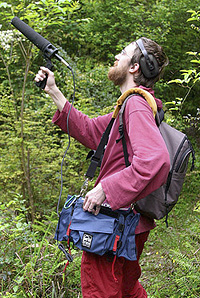 |
Árpád S. Nyári, Clinical Assistant Professor. Avian phylogenetics, phylogeography, character evolution, natural history, collections management.
Ph.D. – 2011, Ecology and Evolutionary Biology, University of Kansas (advisor: A.T. Peterson)
Email: arpad.nyari@okstate.edu |
Specific Interests
My research focuses on the study of evolution of avian lineages at diverse taxonomic and geographic scales, ranging from exploring historical biogeographic patterns at global and regional scales, to investigating more recent processes at the population level. Of particular interest is the historical biogeography and evolution of Australo-Papuan and Southeast Asian taxa. I use comparative approaches across suites of lineages to develop a more synthetic understanding of how evolutionary units respond to ecological and geographic differences through time. This is accomplished through specimen collecting via field expeditions, using a suite of molecular phylogenetic and phylogeographic tools, estimates of diversification rates, reconstructions of present and past climatic envelopes, and analyses of phenotypic and ecological niche evolution.
Selected Publications
- Joseph L., Toon A., Nyári Á.S., Longmore W.N., Rowe K.M.C., Haryoko T., Trueman J., and Gardner J.L. 2014. A new synthesis of the molecular systematics and biogeography of honeyeaters (Passeriformes: Meliphagidae) highlights biogeographical and ecological complexity of a spectacular avian radiation. Zoologica Scripta 43: 235-248.
- Andersen M. J., Nyári Á.S., Mason I., Joseph L., Dumbacher J.P., Filardi C.E., and Moyle R.G. 2014. Molecular systematics of the world’s most polytypic bird- the Pachycephala pectoralis/melanura (Aves: Pachycephalidae) species complex. Zoological Journal of the Linnean Society 170: 566-588.
- Nyári Á.S. and Joseph L. 2013. Comparative phylogeography of Australo-Papuan mangrove-restricted and mangrove-associated avifaunas. Biological Journal of the Linnean Society 109: 574–598.
- Robbins M.B., Schulenberg T.S., Lane D.F., Cuervo A.M., Binford L.C., Nyári Á.S., Combe M., Arbeláez-Cortés E., Wehtje W., and Lira-Noriega A. 2013. Abra Maruncunca, dpto. Puno, Peru, revisited: vegetation cover and avifauna changes over a 30-year period. Bulletin of the British Ornithologist’s Club 133(1): 31-51.
- Nyári Á.S. and Reddy S. 2013. Comparative phyloclimatic analysis and evolution of ecological niches in the scimitar babblers (Aves: Timaliidae: Pomatorhinus). PLoS ONE 8(2): e55629. doi:10.1371/journal.pone.0055629.
- Hosner P.A., Nyári Á.S., and Moyle R.G. 2013. Water barriers and intra-island isolation contribute to diversification in the insular Aethopyga sunbirds (Aves: Nectariniidae). Journal of Biogeography 40: 1094–1106.
- Nyári Á.S. and Joseph L. 2012. Evolution in Australasian mangrove forests: multilocus phylogenetic analysis of the Gerygone warblers (Aves: Acanthizidae). PLoS ONE 7(2): e31840. doi:10.1371/journal.pone.0031840
- Nyári Á.S. and Joseph L. 2011. Systematic fragmentation of Lichenostomus improves the basis for understanding relationships within the honeyeaters (Meliphagidae) and historical development of Australo-Papuan bird communities. Emu 111: 202-211.
- Arbelaez-Cortes E., Nyári Á.S., and Navarro-Sigüenza A.G. 2010. Phylogeographic patterns and historical demography of a Neotropical Montane Forest bird: the Spot-Crowned Woodcreeper (Lepidocolaptes affinis). Molecular Phylogenetics and Evolution 57: 658–668.
- Nyári Á.S., Rathbun G.B., and Peterson A.T. 2010. Late Pleistocene potential distribution of the North African elephant-shrew Elephantulus rozeti (Mammalia: Macroscelidea). African Zoology 45(2): 330–339
